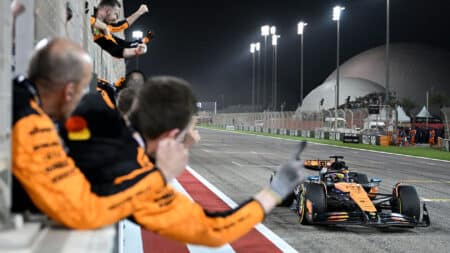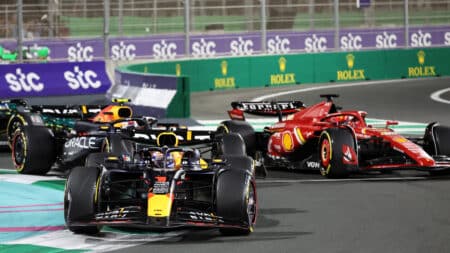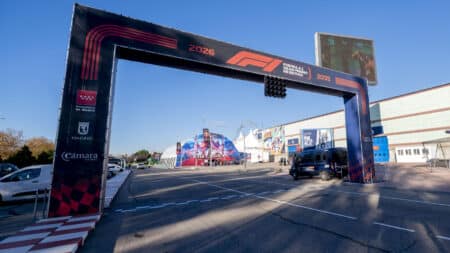The much-heralded switch to a 1000bhp Formula 1 for 2017 is essentially dead. At a recent meeting of engine manufacturers it was agreed that they would not be supporting such a proposal if it was formally made – and without their support, and those of the aligned teams, the way the regulation-making process is now structured, it would be extremely difficult to force it through.

In its place, the manufacturers and the teams have just agreed to a significant reduction in weight instead – which will allow the cars to lap significantly faster than currently. The current minimum weight is set at 692kg, up from 642kg in the V8 era and as little as 500kg in the DFV era (though that did not include the driver, unlike today).

Also in for 2017 is a return to refuelling. Together with the weight reduction, wider tyres and unspecified evolution of aerodynamics, the plan is that the cars will be 5-6sec per lap faster than currently.
The Bernie Ecclestone-favoured proposal of an increase to 1000bhp (around 100bhp more than the current Mercedes and Ferrari motors) for 2017 was to have come from an increase in the maximum permitted fuel flow of the existing turbo hybrid V6s. However, a leading technical director commented: “If we went to 1000bhp, we’d need stronger, heavier tyres to cope, bigger, heavier brakes – and we’d be even heavier than now. We’d be moving towards a WEC-type of car. We want to get away from that and make it more properly an F1 sprint-type car.
“There is a lot more weight in the cars than there needs to be – a lot of that is just legacy. The plank, for example, weighs 12kg, a 10mm thick slice of very dense wood. We don’t really need that now. There are other ways of achieving what that was put there for. We could take a lot of weight out of the cars without compromising their safety in any way – and we feel that’s the way we should be going. We could achieve power-to-weight gains greater than those we’d have had with just an increase to 1,000bhp.”
That said, Thursday’s strategy group meeting agreed to look into ways of increasing the noise of the engines by way of higher revs. This logically implies an increase in the fuel flow.

One of the sticks being used to hit F1 with by its critics is that its lap times are too slow and new records cannot be set. Most of the circuit lap records date from 2004, the last season of pitstop 3-litre V10 races. Since then aerodynamic restrictions, the imposition of the 2.4-litre V8 formula and the current (roughly power-equivalent) hybrid turbo V6s, the end of the tyre war and increases in minimum weight have all pegged speeds back.
The most significant obstacle to lap time improvement in the current formula is not – as has widely, but erroneously, been blamed – the hybrid engines, but the swingeing aerodynamic restrictions that came in simultaneously. The engines actually deliver more performance than the V8s, with more power and vastly more torque – comfortably enough to overcome the associated 50kg increase in weight. Deleting the rear beam wing, narrowing the span of the front wings and the chord of the rear wing has been responsible for these cars struggling to match the times of the V8s.
But the front-running race pace at Barcelona last weekend was about what the crossover time to a wet tyre was back in 2008, when the track was first run to this layout. This was before the imposition of much lower – and more forward-sited – diffuser and heightened front wings of 2009, which took away a lot of aero performance. The 2014 regs took away even more, of course, and now it’s arrived at a point where the spec-series GP2 cars can lap uncomfortably close.
A reduction of, say, 100kg would reduce F1 lap times by around 3sec. This would be quicker than the post-2008 V8s, but still a long way from the full-fat V10s (the best of which were giving around 960bhp). At Bahrain this year Kimi Räikkönen’s fastest lap was 6sec slower than Michael Schumacher’s 2004 record. At Shanghai Lewis Hamilton’s was 8sec slower than Juan Pablo Montoya’s ‘04 record and at Sepang Nico Rosberg was 10sec slower than Schumacher had been in ‘04.

A reduction of 100kg but an increase of 100bhp (to 1000) would bring lap times down by around 4.5sec. A tyre war would probably instantly slash a further 3sec from that, with more to come. But there is just no will from the teams, the promoter or the governing body for that to happen.
As ever, F1 risks introducing new problems in fixing others. Reintroducing the banned aerodynamic aids to get speeds back to record-challenging levels would only make the quality of the racing even worse – the very reason they were eliminated in the first place. Most of those changes were made at the behest of the overtaking working group and while they may not have been as effective as we’d have liked, the racing would certainly have been worse had they just been left.
What is needed – as we said in our blueprint for a new F1 last year – is a thoroughly researched look into whether ground effect aerodynamics would lead to the ability to follow other cars closer through corners (as is widely believed) and whether this would increase the feasibility of overtaking. If so, then new ground effect aero rules could comfortably have the cars eclipsing those old 2004 records.
Then we’d have the complaint that the grip of these ground effect cars was making them go round on rails and the drivers’ skills were no longer visible. Some might even be referring nostalgically to the ‘good old days’ of the early turbo hybrid V6s of 2014-15 which had so little grip that the drivers could be seen really working through the slow and medium speed corners, and why oh why did F1 get itself so worked up about lap records?








